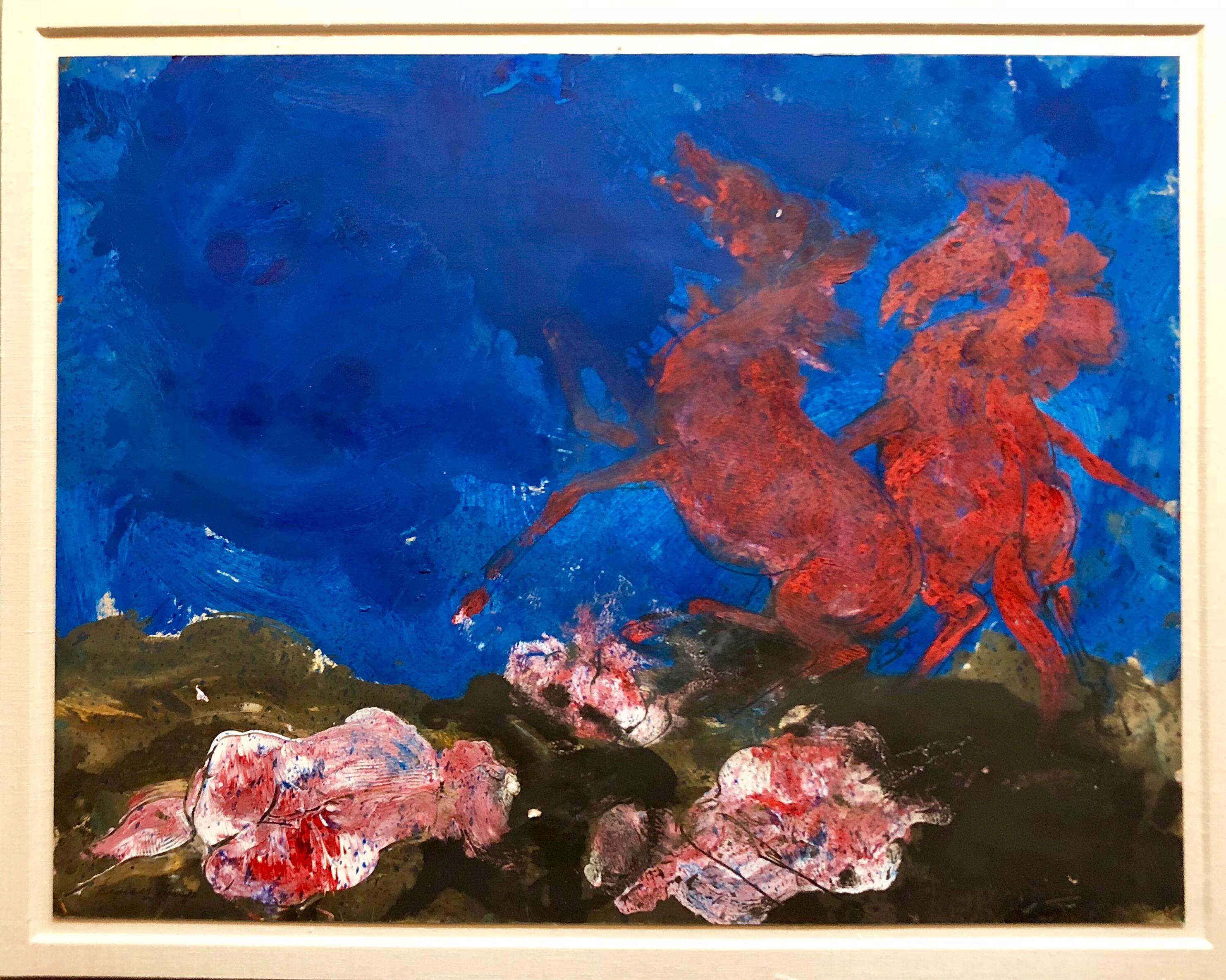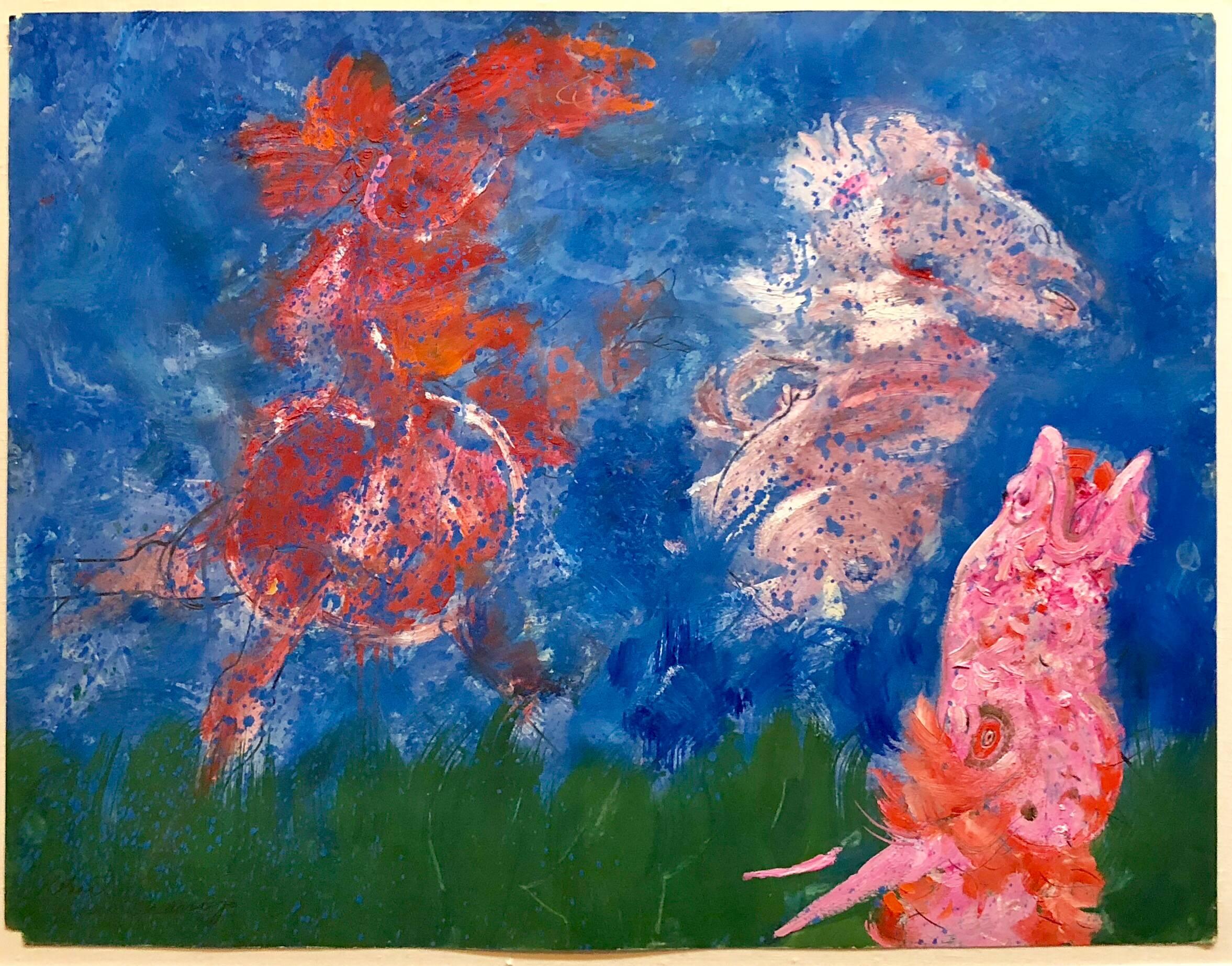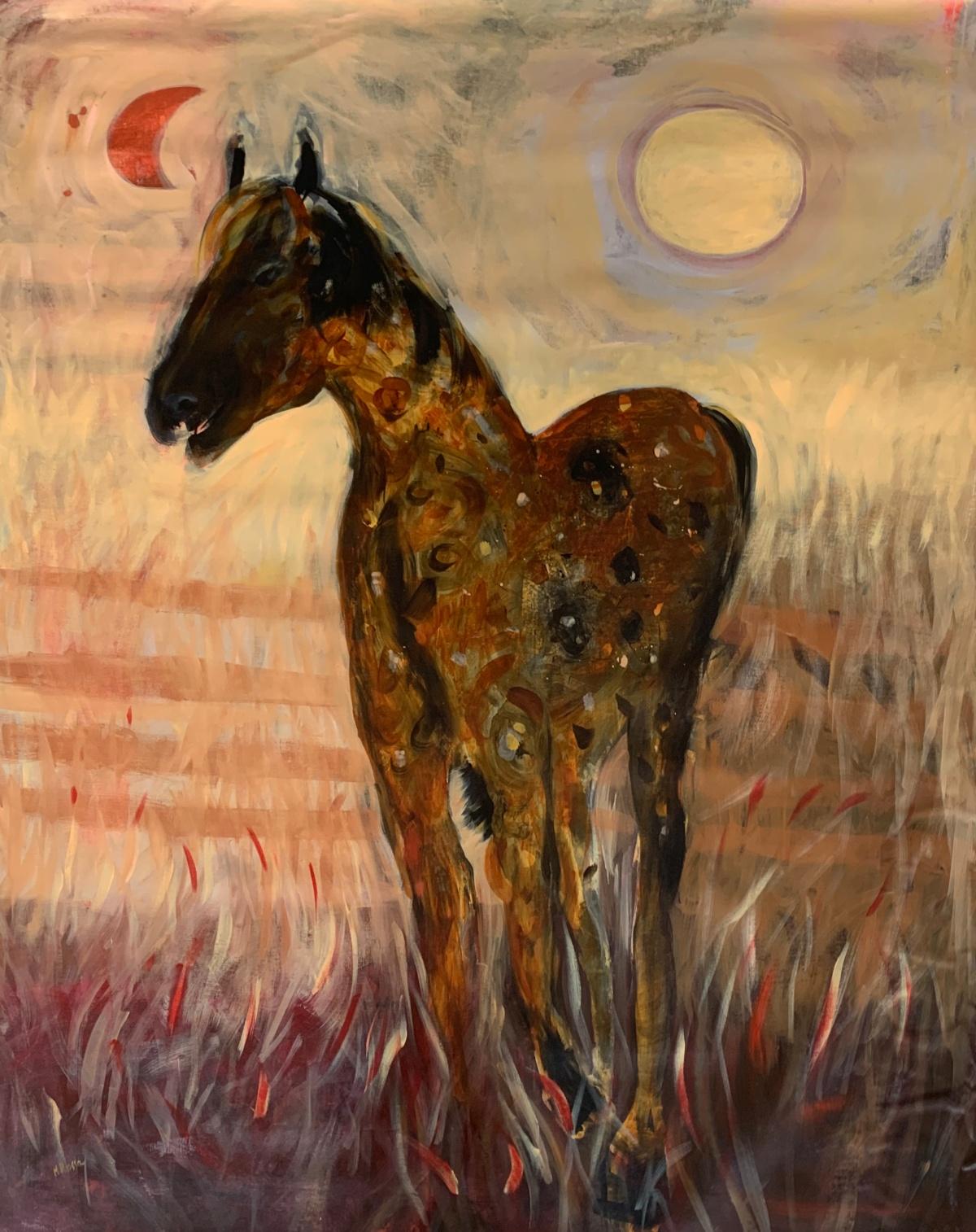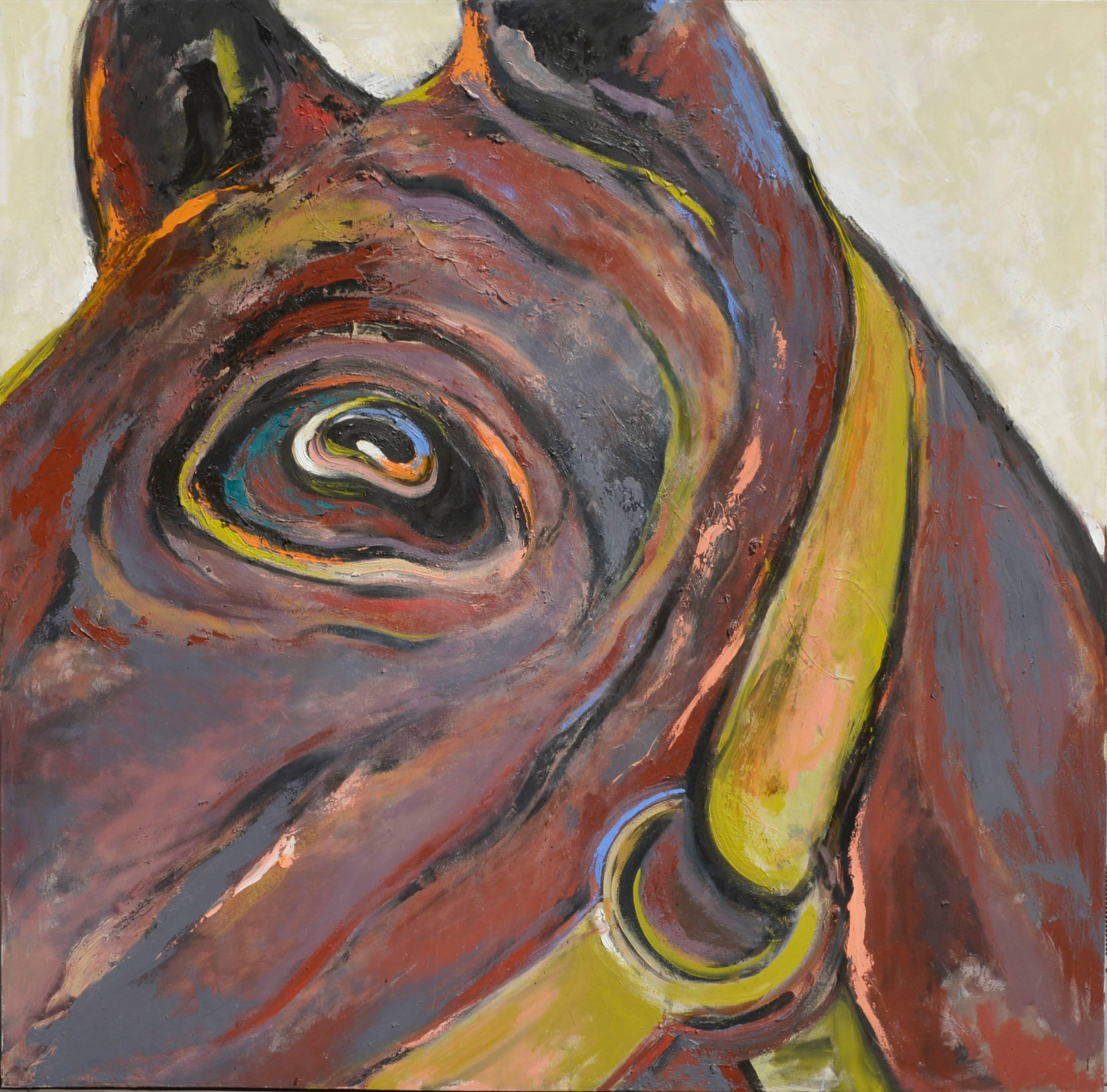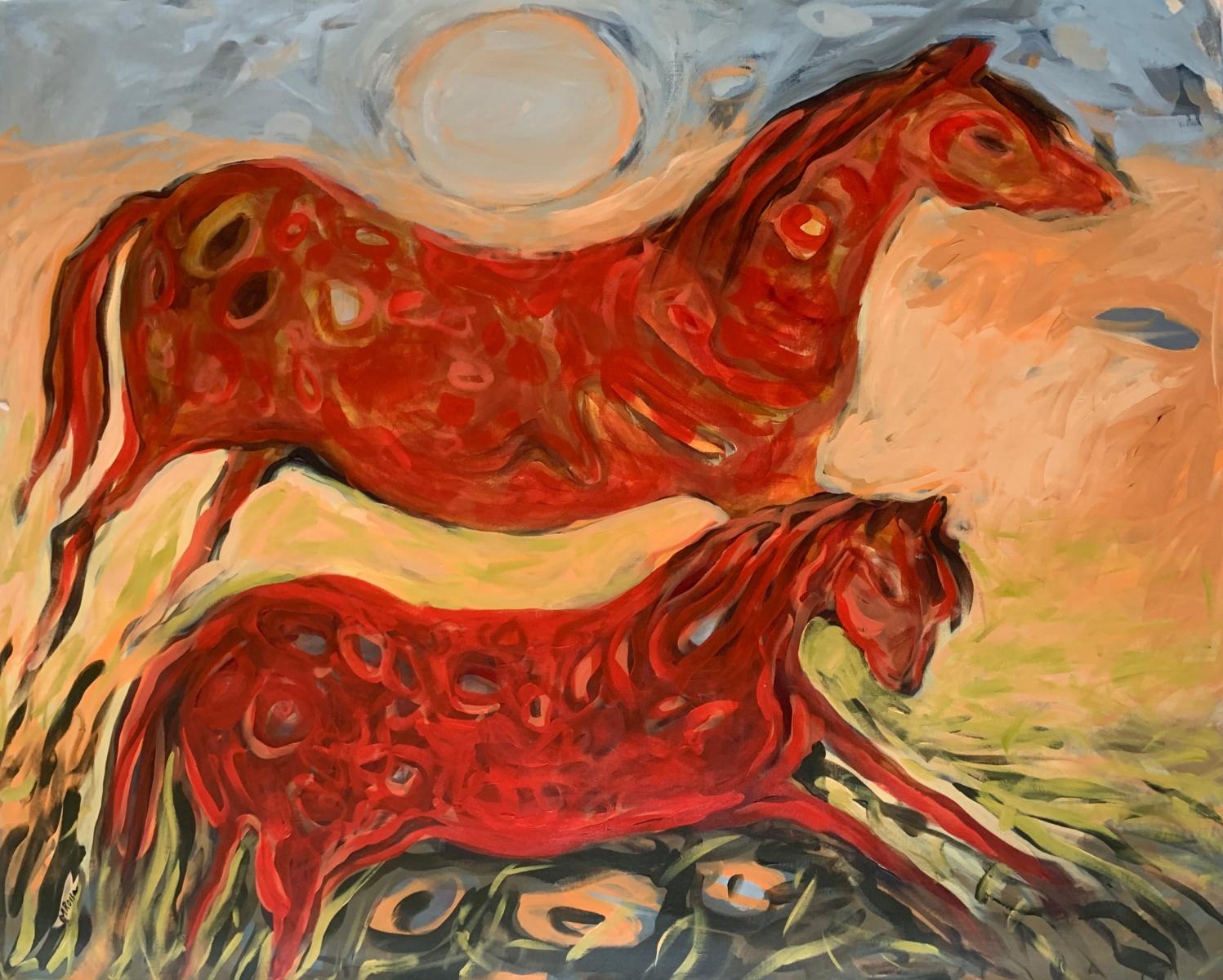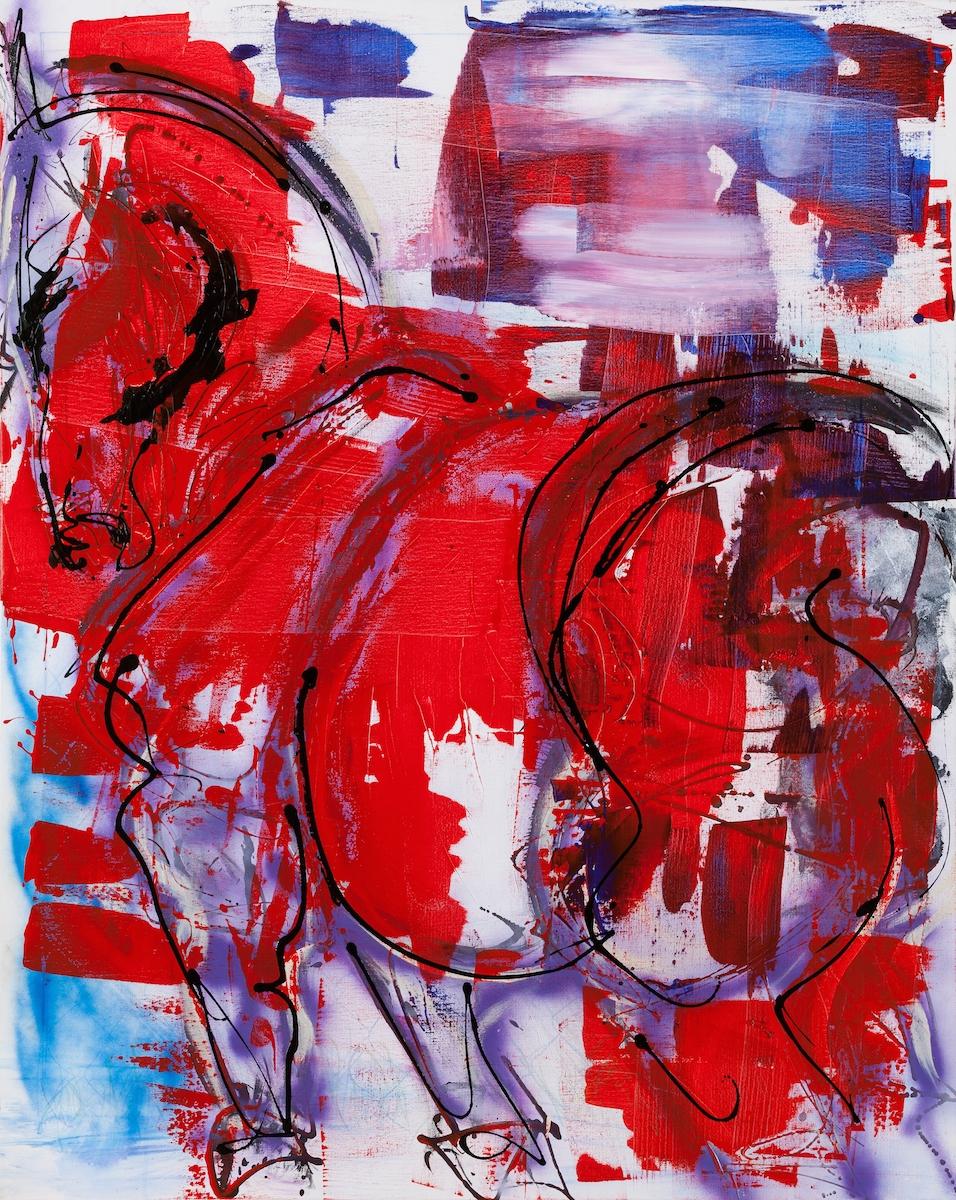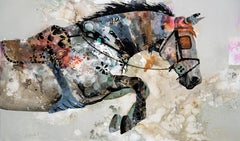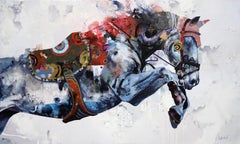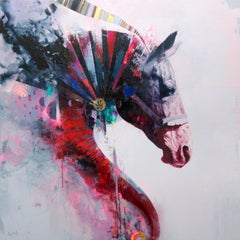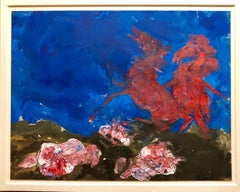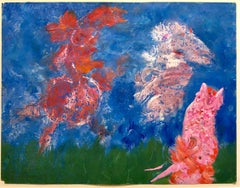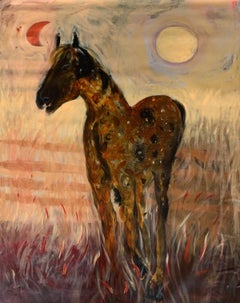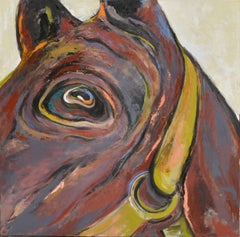Items Similar to Wild Horse, abstract, figurative oil on linen, rich bold colors
Want more images or videos?
Request additional images or videos from the seller
1 of 11
Toni FranovicWild Horse, abstract, figurative oil on linen, rich bold colors2012
2012
$2,213
$2,95024% Off
£1,668.82
£2,224.5924% Off
€1,930.07
€2,572.8524% Off
CA$3,104.83
CA$4,138.8324% Off
A$3,451.21
A$4,600.5724% Off
CHF 1,809.05
CHF 2,411.5224% Off
MX$42,147.60
MX$56,184.1124% Off
NOK 22,584.94
NOK 30,106.4524% Off
SEK 21,248.21
SEK 28,324.5524% Off
DKK 14,405.50
DKK 19,202.9924% Off
About the Item
Toni Franović was born in Zagreb on April 15th, 1964. He is a graduate of the Academy of Fine Arts in Zagreb, where he studied under professor Vasilije Jordan. In 1992/93 he joined the Fine Arts Project in Arad, Israel. During the academic year of 1994/95 he was an artist in residence at Kresge Academic Center, American University in Washington D.C. From 1995 to 2004 he worked as an assistant professor at the Academy of Fine Arts, University of Zagreb. During that period he was the head of drawing and painting field work at the same Academy of Fine Arts (Legrad, Brač, Hvar, Mljet...).
He is a fine arts consultant of the Center for Jewish Culture and Creativity of Los Angeles since 1992, as well as the center’s representative for Europe. He is affiliated with Judaica Project Foundation, Washington D.C., since 2000. His works are found in public and private art collections in Europe and the United States including the U.S. Department of State, World Bank in Washington D.C. and the E.l. Ritz Collection in Milwaukee. Numerous public buildings have his applied art design, such as Ohr Kodesh Synagogue and Chapel and Oxnam Church, Greater Washington Area, and Central Department Store ‘Nama’ and JCC Building in Zagreb, Croatia.
- Creator:Toni Franovic (1964, Croatian)
- Creation Year:2012
- Dimensions:Height: 24 in (60.96 cm)Width: 48 in (121.92 cm)Depth: 1 in (2.54 cm)
- Medium:
- Movement & Style:
- Period:
- Condition:
- Gallery Location:Dallas, TX
- Reference Number:1stDibs: LU64033116693
About the Seller
4.8
Vetted Professional Seller
Every seller passes strict standards for authenticity and reliability
Established in 2004
1stDibs seller since 2017
199 sales on 1stDibs
Typical response time: 6 hours
Associations
Association of Women Art Dealers
- ShippingRetrieving quote...Shipping from: Dallas, TX
- Return Policy
Authenticity Guarantee
In the unlikely event there’s an issue with an item’s authenticity, contact us within 1 year for a full refund. DetailsMoney-Back Guarantee
If your item is not as described, is damaged in transit, or does not arrive, contact us within 7 days for a full refund. Details24-Hour Cancellation
You have a 24-hour grace period in which to reconsider your purchase, with no questions asked.Vetted Professional Sellers
Our world-class sellers must adhere to strict standards for service and quality, maintaining the integrity of our listings.Price-Match Guarantee
If you find that a seller listed the same item for a lower price elsewhere, we’ll match it.Trusted Global Delivery
Our best-in-class carrier network provides specialized shipping options worldwide, including custom delivery.More From This Seller
View AllUrban Glare- abstract figurative oil on linen, rich bright colors
By Toni Franovic
Located in Dallas, TX
Toni Franović was born in Zagreb on April 15th, 1964. He is a graduate of the Academy of Fine Arts in Zagreb, where he studied under professor Vasilije Jordan...
Category
2010s Contemporary Abstract Paintings
Materials
Linen, Oil
$3,040 Sale Price
20% Off
Passage Abstrait, Warm colorful Horse oil painting, abstract realism and texture
By Eric Robitaille
Located in Dallas, TX
"Passage Abstrait" is a contemporary large scale oil painting by Canadian artist Eric Robitaille depicting a racy, colorful and powerful horse. Created using a bold color palette, la...
Category
2010s Contemporary Animal Paintings
Materials
Canvas, Oil, Acrylic
No Return, Colorful Horse oil painting, abstract realism and texture, blue grey
By Eric Robitaille
Located in Dallas, TX
"No Return" is a contemporary large scale oil painting by Canadian artist Eric Robitaille depicting a racy, colorful and powerful horse. Created using a bold color palette, layered t...
Category
2010s Contemporary Animal Paintings
Materials
Canvas, Oil
Quintessence, Abstract Realism Horse Painting, bright palette, design texture
By Eric Robitaille
Located in Dallas, TX
"Quintessence" is a gorgeous and powerful oil painting of a horse, perfect for equestrians or design lovers! Artist Eric Robitaille uses a rich realist technique to draw focus on the...
Category
2010s Contemporary Animal Paintings
Materials
Canvas, Oil, Acrylic
The Head of the House, abstract figurative oil on linen, rich bold colors
By Toni Franovic
Located in Dallas, TX
Toni Franović was born in Zagreb on April 15th, 1964. He is a graduate of the Academy of Fine Arts in Zagreb, where he studied under professor Vasilije Jordan...
Category
2010s Contemporary Figurative Paintings
Materials
Cotton Canvas, Oil
$2,120 Sale Price
20% Off
Purple Tree - abstract impressionist, figurative oil on linen, rich bold colors
By Toni Franovic
Located in Dallas, TX
Toni Franović was born in Zagreb on April 15th, 1964. He is a graduate of the Academy of Fine Arts in Zagreb, where he studied under professor Vasilije Jordan...
Category
2010s Contemporary Abstract Paintings
Materials
Linen, Oil
You May Also Like
American Neo Expressionist "Wild Horses" Modernist Oil Painting
By Robert Beauchamp
Located in Surfside, FL
Robert Beauchamp (1923 – March 1995) was an American figurative painter and arts educator. Beauchamp's paintings and drawings are known for depicting dramatic creatures and figures with expressionistic colors. His work was described in the New York Times as being "both frightening and amusing,". He was a Guggenheim Fellow and a student of Hans Hofmann.
Robert Beauchamp was born in Denver, Colorado in 1923. He had three brothers and three sisters, and the children were orphaned by both parents by the time Beauchamp was three. The family grew up impoverished due to the Great Depression, living in a community house with other families. As a child he dabbled in art but it wasn't until high school that he began taking art classes. When not creating art he also played sports; football and basketball, and enjoyed chemistry and geology.
He was told he was good at drawing, and replaced study hall classes with art classes, receiving instruction and inspiration from a Welsh teacher named R. Idris Thomas. While in high school Beauchamp would go, every Monday, to the public library and a local museum where he would read books about art; specifically French painting, as assigned by Thomas. Beauchamp absorbed the tenets of European Modernism and American Abstract Expressionism—with which he eventually broke. While abstraction, with its focus on color and form, underlies his compositions, he filled canvas and paper with psychologically acute portraits of himself and others, nudes, animals, and objects of all kinds. Beauchamp would spend upwards of four hours a day in the art room and eventually won the Carter Memorial Prize, which provided a scholarship to the Colorado Springs Fine Arts Center. At Colorado Springs he studied under Boardman Robinson, painting landscapes in nature.
Beauchamp eventually joined the Navy and then returned to Colorado Springs to continue his studies. Traveling the world as an Armed Guard, he spent a year and a half at sea and the rest of the three years in San Francisco. Seeking to make money, and to follow his love for a girl, Beauchamp decided to attend Cranbrook Academy of Art from 1947–1948. There he studied pottery, believing one could "make more money selling pots than you could selling paintings." He described his experience at Cranbrook as intimidating and claustrophobic, and eventually switched to sculpture before switching to painting.
Beauchamp moved to New York City in the early 1950s and was involved in the Tenth Street galleries, which provided outlets for more experimental artists and the second generation of abstract expressionists. Despite his involvement with 10th Street and friendships with abstract artists, abstract art never interested in him. He showed at numerous galleries in New York and Provincetown, socializing with gallery owners, artists and collectors. His first exhibition was at the Tanager Gallery in New York, he also showed during the 1950s at the Hansa Gallery. In New York and Provincetown he studied under Hans Hofmann Eventually he felt that abstract expressionism became dull and stalemated.
During the 1960s he showed at the Green Gallery. C. 1960 he was awarded a Fulbright Award allowing him to travel to La Romola, Italy. He traveled frequently to cities such as Rome and worked constantly. Beauchamp returned to the states and lived in Provincetown at Walter Gutman's house, who awarded Beauchamp a grant. That year he met his future wife, Nadine Valenti, whom he married in 1967. Beauchamp taught at a variety of schools during his lifetime including Brooklyn College, School of Visual Arts, Cooper Union and the Art Students League of New York during the last fifteen years of his life.
Beauchamp described his drawings as painterly, seeking the spontaneity in an image. He would develop a drawing then a painting, and vice versa. His heavily impastoed paintings, often described as sculptures themselves, came from the pouring of paint from a can, with little planning and constant evolution in the medium upon the canvas. He preferred little planning to his creations, believing that an artists work would become stale and repetitive with constant planning.
He also created large scale works, at times 70 inches long. Beauchamp had little intention of ever selling his large works, preferring to create them due to the slow and intense experience he received from the process. The large drawings he created on the floor, and the smaller works were created on a table. Paintings were created on either the floor or wall and he described his painting process as "splattering", "pushing the paint around," and sponging.
Animals often appear in his paintings, despite a dislike for domestic animals outside of his artistic creations. He called the characters in his paintings as Beauchamps. Some Beauchamps hold meaning, with Beauchamp rarely sharing the meaning behind the symbols and characters. He made up the creatures himself, seeking to emphasize the character of each.
In 2006 the University of Massachusetts Amherst College of Visual & Performing Arts hosted an exhibition of Beauchamp's pieces from the 1960s, curators stated that Beauchamp's work: "effortlessly blends innovative style elements with narrative, descriptive images. One senses equal enjoyment in the manipulation of, and interaction with, color and paint, and the often sudden and unexpected presence of a wasp or a lump of sugar."
included in the important exhibit "Twelve New York Painters." New York: David Findlay Jr. Fine Art with Mary Abbott, Alcopley, Robert Beauchamp, Byron Browne, Charles Cajori, Jim Forsberg, Carl Heidenreich, Angelo Ippolito, Emily Mason, Robert Natkin, Robert Richenburg and Nina Tryggvadottir...
Category
20th Century Neo-Expressionist Abstract Paintings
Materials
Paper, Oil
American Neo Expressionist "Wild Horses" Modernist Oil Painting
By Robert Beauchamp
Located in Surfside, FL
Signed lower left.
Robert Beauchamp (1923 – March 1995) was an American figurative painter and arts educator. Beauchamp's paintings and drawings are known for depicting dramatic creatures and figures with expressionistic colors. His work was described in the New York Times as being "both frightening and amusing,". He was a Guggenheim Fellow and a student of Hans Hofmann.
Robert Beauchamp was born in Denver, Colorado in 1923. He had three brothers and three sisters, and the children were orphaned by both parents by the time Beauchamp was three. The family grew up impoverished due to the Great Depression, living in a community house with other families. As a child he dabbled in art but it wasn't until high school that he began taking art classes. When not creating art he also played sports; football and basketball, and enjoyed chemistry and geology.
He was told he was good at drawing, and replaced study hall classes with art classes, receiving instruction and inspiration from a Welsh teacher named R. Idris Thomas. While in high school Beauchamp would go, every Monday, to the public library and a local museum where he would read books about art; specifically French painting, as assigned by Thomas. Beauchamp absorbed the tenets of European Modernism and American Abstract Expressionism—with which he eventually broke. While abstraction, with its focus on color and form, underlies his compositions, he filled canvas and paper with psychologically acute portraits of himself and others, nudes, animals, and objects of all kinds. Beauchamp would spend upwards of four hours a day in the art room and eventually won the Carter Memorial Prize, which provided a scholarship to the Colorado Springs Fine Arts Center. At Colorado Springs he studied under Boardman Robinson, painting landscapes in nature.
Beauchamp eventually joined the Navy and then returned to Colorado Springs to continue his studies. Traveling the world as an Armed Guard, he spent a year and a half at sea and the rest of the three years in San Francisco. Seeking to make money, and to follow his love for a girl, Beauchamp decided to attend Cranbrook Academy of Art from 1947–1948. There he studied pottery, believing one could "make more money selling pots than you could selling paintings." He described his experience at Cranbrook as intimidating and claustrophobic, and eventually switched to sculpture before switching to painting.
Beauchamp moved to New York City in the early 1950s and was involved in the Tenth Street galleries, which provided outlets for more experimental artists and the second generation of abstract expressionists. Despite his involvement with 10th Street and friendships with abstract artists, abstract art never interested in him. He showed at numerous galleries in New York and Provincetown, socializing with gallery owners, artists and collectors. His first exhibition was at the Tanager Gallery in New York, he also showed during the 1950s at the Hansa Gallery. In New York and Provincetown he studied under Hans Hofmann Eventually he felt that abstract expressionism became dull and stalemated.
During the 1960s he showed at the Green Gallery. C. 1960 he was awarded a Fulbright Award allowing him to travel to La Romola, Italy. He traveled frequently to cities such as Rome and worked constantly. Beauchamp returned to the states and lived in Provincetown at Walter Gutman's house, who awarded Beauchamp a grant. That year he met his future wife, Nadine Valenti, whom he married in 1967. Beauchamp taught at a variety of schools during his lifetime including Brooklyn College, School of Visual Arts, Cooper Union and the Art Students League of New York during the last fifteen years of his life.
Beauchamp described his drawings as painterly, seeking the spontaneity in an image. He would develop a drawing then a painting, and vice versa. His heavily impastoed paintings, often described as sculptures themselves, came from the pouring of paint from a can, with little planning and constant evolution in the medium upon the canvas. He preferred little planning to his creations, believing that an artists work would become stale and repetitive with constant planning.
He also created large scale works, at times 70 inches long. Beauchamp had little intention of ever selling his large works, preferring to create them due to the slow and intense experience he received from the process. The large drawings he created on the floor, and the smaller works were created on a table. Paintings were created on either the floor or wall and he described his painting process as "splattering", "pushing the paint around," and sponging.
Animals often appear in his paintings, despite a dislike for domestic animals outside of his artistic creations. He called the characters in his paintings as Beauchamps. Some Beauchamps hold meaning, with Beauchamp rarely sharing the meaning behind the symbols and characters. He made up the creatures himself, seeking to emphasize the character of each.
In 2006 the University of Massachusetts Amherst College of Visual & Performing Arts hosted an exhibition of Beauchamp's pieces from the 1960s, curators stated that Beauchamp's work: "effortlessly blends innovative style elements with narrative, descriptive images. One senses equal enjoyment in the manipulation of, and interaction with, color and paint, and the often sudden and unexpected presence of a wasp or a lump of sugar."
included in the important exhibit "Twelve New York Painters." New York: David Findlay Jr. Fine Art with Mary Abbott, Alcopley, Robert Beauchamp, Byron Browne, Charles Cajori, Jim Forsberg, Carl Heidenreich, Angelo Ippolito, Emily Mason, Robert Natkin, Robert Richenburg and Nina Tryggvadottir...
Category
20th Century Neo-Expressionist Abstract Paintings
Materials
Paper, Oil
A Horse - Contemporary Oil Painting, Colorful
By Monika Rossa
Located in Warsaw, PL
MONIKA ROSSA
studied painting at the University of Arizona, in the Ecole des Beaux Arts in Paris and at the Escuela de Diseno in Barcelona. She practices drawing and easel painting....
Category
21st Century and Contemporary Contemporary Figurative Paintings
Materials
Canvas, Oil
Large Original Oil Painting Abstract Expressionist Horse
Located in Soquel, CA
Stunning large scale abstract expressionist horse's head/eye, circa 1990. Unsigned. Unframed. Size: 60"H x 60"W x 1.5.
Category
1990s Abstract Impressionist Animal Paintings
Materials
Canvas, Oil, Stretcher Bars
$2,000 Sale Price
20% Off
Two horses. Contemporary Abstract Oil Painting, Colorful, Dynamic, Polish art
By Monika Rossa
Located in Warsaw, PL
Abstract painting by Polish artist living in USA Monika Rossa. Painting depicts two horses running, it is in warm colors. The background is abstract and it is dynamic.
MONIKA ROSSA ...
Category
21st Century and Contemporary Contemporary Figurative Paintings
Materials
Canvas, Oil
The Patriot Horse Artwork, Painting, Acrylic on Canvas
By Donna Bernstein
Located in Yardley, PA
My signature style combines accurate anatomy with compelling universal personalities. Evoking the dreams, ideals or tragedies embodied by the classic horse I continue in the tradition of the symbolic in equine art. In ""The Patriot""the harnessed strength of the workhorse infused with the red, white and blue becomes homage to the iconic animals who built this county beside us. They are the true patriots...
Category
2010s Abstract Abstract Paintings
Materials
Acrylic
More Ways To Browse
European Horse Painting
Jordanian Oil Painting
L Toni
Vasilije Jordan
Jockey On Horse Painting
Monkey Oil Painting
Blue Whale
Jungle Cats
Paintings Of Leopards
Este Italy
Paintings Of Ravens
Hawaiian Wood Sculpture
Collie Painting
Stag Painting
Arabian Horse Art
Bunny Sculpture Hunt Slonem
Horse With Jockey Paintings
Squirrel Painting
